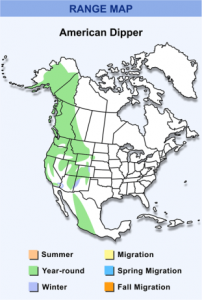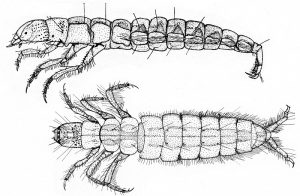The American Dipper is a migratory bird, but perhaps not in the way you would imagine. Some populations are altitudinal migrants, meaning that they seasonally move from lower to higher elevations. During the spring, some Dipper individuals head upstream and into the mountains, this is thought to minimize some of the competition for nesting sites. Juvenile dippers have also been found in high elevation lakes, especially when there are steep rocky cliffs and lots of caddisfly larvae, these may act as a seasonal niche (Garwood, 2009).
 The disadvantage of this migration is lower productivity and survival rates than seen in the year-round residential birds, but some of these findings may be due to less competent individuals being the ones forced to these higher elevations (Green et al. 2015). Despite this, it was also observed that residents rested more frequently and foraged less than migrating birds, but this resulted in no difference in the success of foraging, total energetic intake and physiological state between the two lifestyles (Whitehorne, 2010).
The disadvantage of this migration is lower productivity and survival rates than seen in the year-round residential birds, but some of these findings may be due to less competent individuals being the ones forced to these higher elevations (Green et al. 2015). Despite this, it was also observed that residents rested more frequently and foraged less than migrating birds, but this resulted in no difference in the success of foraging, total energetic intake and physiological state between the two lifestyles (Whitehorne, 2010).
According to Morrissey et al. over 80 percent of Dippers migrate to higher elevations (2004). Other theories that Green et al. proposed for the advantages of migration include avoiding predators such as steelhead trout, merlins, sharp-shinned and coopers hawks, as well as minimizing breeding attempts, and therefor reducing the cost of reproduction, lastly migration can allow for less efforts spent defending territory (2015).
As mentioned in my previous post, the American Dipper lives stream-side, and obtains the majority of its food from within the stream. This means that any sort of chemicals within the stream that can be taken up by the birds, will be present in their system. Several studies have attempted to utilize the American Dipper in order to measure contamination levels in streams.
Morrissey et al. studied the concentrations of nine different metals known to persist in watersheds. They found that resident Dippers, who lived in the same place year-round, had more mercury, cadmium, and copper present in feather samples. Overall most of the metals tested were below the tolerable daily intake, and some increased levels of specific elements were associated with certain diets, mercury in fish eaters and cadmium, copper and arsenic in insect consumers (2004). American Dippers have also been observed for the effects of mercury released from mining sites. Henny et al. discovered, after thorough testing, that although the mine site did contain birds with higher levels of mercury than other areas, it was not at levels high enough to cause adverse effects on offspring (2005).
Morrisey et al. also conducted a study on the transportation of contaminants through spawning Pacific Salmon by observing American Dippers. Dippers eat salmon fry, and accumulate toxins within their tissues. Despite these conclusions, the differences in levels of PCB’s in these birds was still similar to the amount accumulated from the atmosphere, and were not shown to have an effect on the American Dipper (2012).
Despite this species being considered a good indicator of stream health, many of the studies on them have been inconclusive, and have not shown a significant impact from toxins in the area.
References:
Garwood, J., Pope, K., Bourque, R., & Larson, M. (2009). High Mountain Lakes Provide a Seasonal Niche for Migrant American Dippers. The Wilson Journal of Ornithology, 121(3), 600-609. Retrieved from http://www.jstor.org.ezproxy.viu.ca/stable/20616947
Green, D. J., Whitehorne, I. B. J., Middleton, H. A., & Morrissey, C. A. (2015). Do american dippers obtain a survival benefit from altitudinal migration? PloS One, 10(4), e0125734. doi:10.1371/journal.pone.0125734
Henny, C. J., Kaiser, J. L., Packard, H. A., Grove, R. A., & Taft, M. R. (2005). Assessing mercury exposure and effects to american dippers in headwater streams near mining sites.Ecotoxicology, 14(7), 709-725. doi:10.1007/s10646-005-0023-7
Morrissey, C. A., Bendell-Young, L. I., & Elliott, J. E. (2004). seasonal trends in population density, distribution, and movement of american dippers within a watershed of southwestern british columbia, canada. The Condor, 106(4), 815-825. doi:10.1650/7455
Morrissey, C. A., Pollet, I. L., Ormerod, S. J., & Elliott, J. E. (2012). American dippers indicate contaminant biotransport by pacific salmon. Environmental Science & Technology, 46(2), 1153.
Whitehorne, I. (2010). Wintering Behavior, Physiology and Site Fidelity in a Partial Migrant, the American Dipper (Cinclus mexicanus). Waterbirds: The International Journal of Waterbird Biology, 33(4), 461-470. Retrieved from http://www.jstor.org.ezproxy.viu.ca/stable/40985865
*Image references will open when clicked.


Do you know if there’s a limit to how deep they can dive? I imagine deeper water has better fishing, but most pictures of these guys they’re in pretty shallow streams.
Also, do they time any of their expensive behaviours (nesting, mating, etc) with the salmon cycles?
I could not find any concrete information on the depths that they dive, but I do know that their dives are brief, unlike a diving duck that may stay underwater for some time. According to this article, in Alaska they do take advantage of the salmon run and eat many eggs and small hatchling salmon: https://www.adfg.alaska.gov/static/education/wns/american_dipper.pdf